Chevrolet Kalos User Manual

FOREWORD
This manual will acquaint you with the operation and maintenance of your new vehicle. It will also provide you with important safety information. Read it carefully and follow the recommendations for the enjoyable, safe, and trouble-free operation of your vehicle.
Service will best be provided by your authorized repairer who knows your vehicle best and is dedicated to your complete satisfaction.
Please consider this manual a permanent part of your new car. It should remain with the vehicle at all times, including at time of resale.
Thank you for choosing our vehicle.
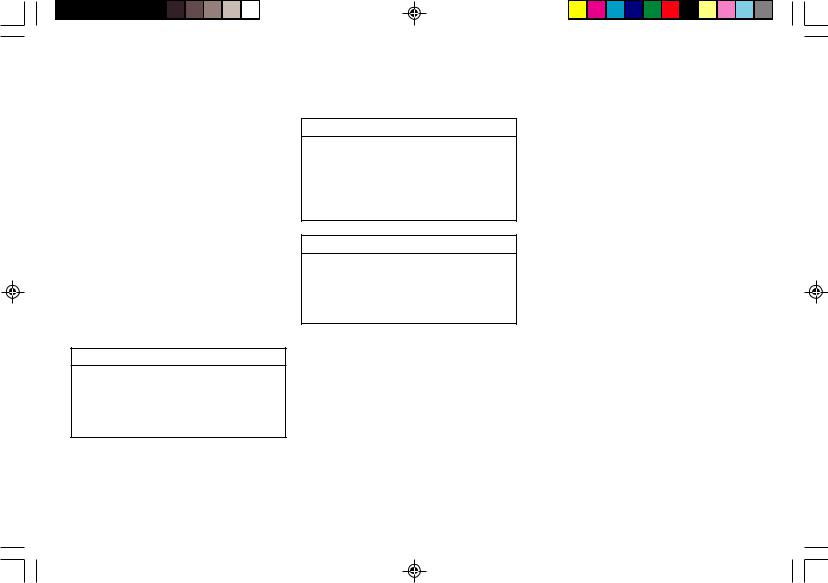
IMPORTANT NOTICE
Please read this manual and follow the instructions carefully.
v: This is the safety alert symbol used to alert you to potential hazards including injuries or damage to your vehicle or other property. Obey all safety messages that follow this symbol.
Throughout this manual you will find special notations:
•Warning
•Caution
•Note
v WARNING
WARNING indicates a potentially hazardous situation which, if not avoided, could result in serious injury or death.
v CAUTION
CAUTION indicates a potentially hazardous situation which, if not avoided, may result in minor or moderate injuries, or damage to your vehicle or other property.
NOTE
NOTE indicates information which will assist you with maintenance or other instructions concerning your vehicle.
*or (option): The asterisk and (option) in this manual signify an item of equipment that is not included on all vehicles. Such items include engine options, model variations specific to one country, and optional equipment.
All information, illustrations, and specifications in this manual are based on the latest product information available at the time of publication.
We reserve the right to change specifications or designs at any time without notice and without incurring obligation.
This vehicle may not comply with the standards or regulations of other countries. Before attempting to register this vehicle in any other country, check all applicable regulations and make any necessary modifications.
This manual describes the options and trims available at the time of publication. Some of the items covered may not apply to your vehicle. Contact your distributor for information on option and trim availability.
NonGenuine parts and accessories have not been examined or approved by our company. We can certify neither the suitability nor the safety of nonGenuine parts and accessories and are not liable for damage caused by their use.
Important: Read Section 1 ("Seats and Occupant Protection Systems") of this manual fully and carefully before operating your vehicle.
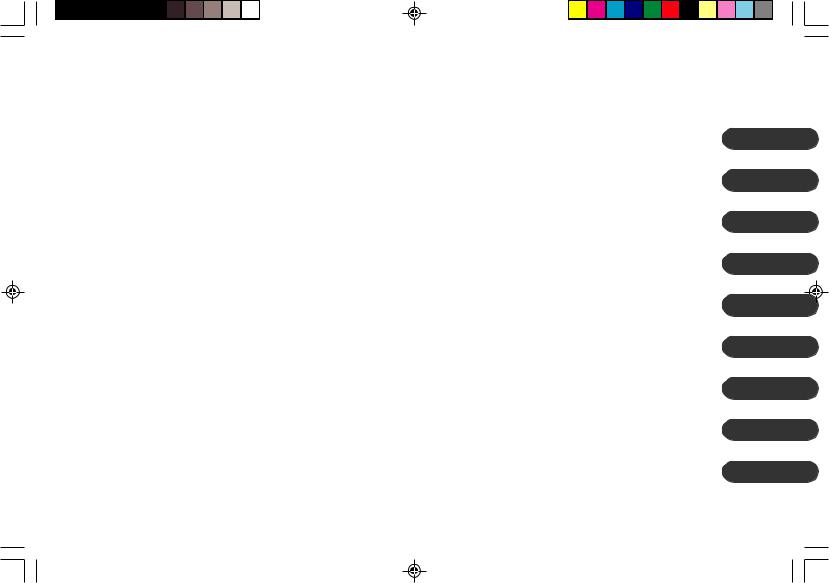
TABLE OF CONTENTS
1. SEATS AND OCCUPANT PROTECTION SYSTEMS ................................................................................ |
1-1 |
(Important information about safety belts, air bags, child seats and other safety features)
2. |
INSTRUMENTS AND CONTROLS ........................................................................................................... |
2-1 |
|
(Information about instruments, gauges and vehicle controls) |
|
3. |
DRIVING YOUR VEHICLE ...................................................................................................................... |
3-1 |
|
(Information about how to drive your vehicle under various conditions.) |
|
4. |
CLIMATE CONTROL AND AUDIO SYSTEM ......................................................................................... |
4-1 |
|
(How to operate your heating, ventilation, air conditioning and audio systems) |
|
5. |
EMERGENCIES ......................................................................................................................................... |
5-1 |
|
(Important information about what to do if you have a problem while driving) |
|
6. |
SERVICE AND VEHICLE CARE. ............................................................................................................. |
6-1 |
|
(Information about how to properly maintain your vehicle.) |
|
7. |
VEHICLE MAINTENANCE ....................................................................................................................... |
7-1 |
|
(Information about vehicle maintenance) |
|
8. |
TECHNICAL INFORMATION .................................................................................................................. |
8-1 |
|
(Vehicle specifications, lubricant types and other useful information) |
|
9. |
INDEX ...................................................................................................................................................... |
9-1 |
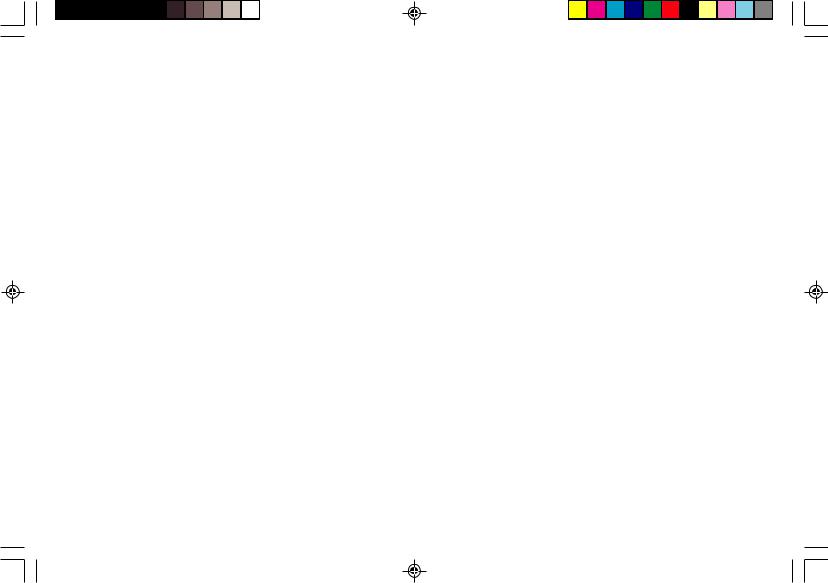

SEATS AND OCCUPANT PROTECTION SYSTEMS 1–1
1 SEATS AND OCCUPANT PROTECTION SYSTEMS
• ALWAYS WEAR YOUR SAFETY BELTS ................... |
1-2 |
• PREGNANT WOMEN AND SAFETY BELTS ......... |
1-10 |
||
• |
FRONT SEAT OCCUPANTS ................................... |
1-6 |
• |
CHILD RESTRAINT .............................................. |
1-10 |
• |
REAR SEAT OCCUPANTS ...................................... |
1-6 |
• LOWER CHILD RESTRAINT ANCHORS .............. |
1-12 |
|
• SAFETY BELT WARNING CHIME ........................... |
1-6 |
• |
HEAD RESTRAINTS ............................................. |
1-14 |
|
• |
THREE-POINT SAFETY BELTS ............................... |
1-6 |
• |
FRONT SEATS ..................................................... |
1-15 |
• |
SAFETY BELT PRETENSIONER ............................... |
1-8 |
• |
REAR SEATS ......................................................... |
1-17 |
• SAFETY BELT HEIGHT ADJUSTMENT ................... |
1-8 |
• |
SUPPLEMENTAL RESTRAINT SYSTEM |
|
|
• REMOVABLE CENTER REAR SAFETY BELT |
1-9 |
|
(AIR BAG) ............................................................ |
1-21 |
|
|
|
|
|||
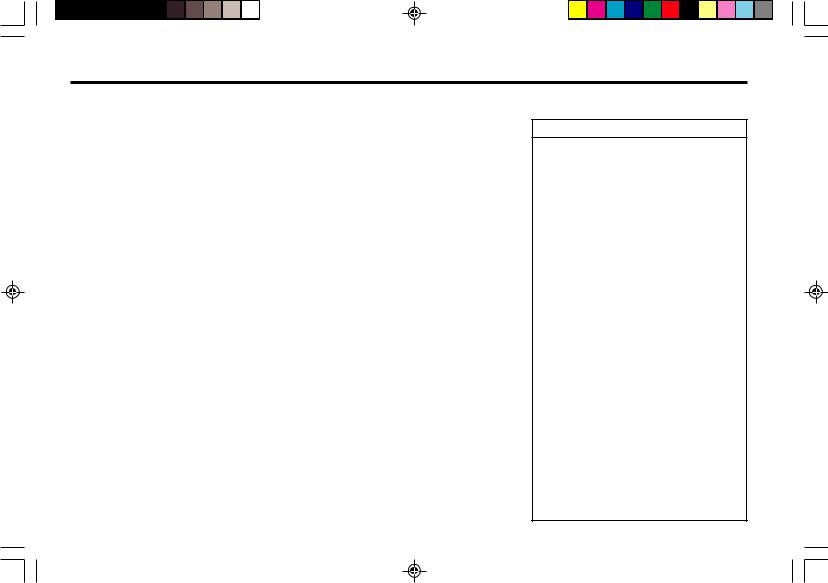
1–2 SEATS AND OCCUPANT PROTECTION SYSTEMS
ALWAYS WEAR YOUR SAFETY BELTS!
Occupant protection has been the focus of much private and public research and development for many years. The two vehicle components which are incorporated into the vehicle solely for the protection of the occupants in vehicle accidents are the safety belts provided at each seating position and the supplemental restraint system, or air bags, provided at the driver and front passenger seat positions. The safety belts can protect you and your passengers only if they are used. The air bag is a supplemental protective device that is more effective and safer as a restraining device when the safety belts are being used.
WHY WEAR SAFETY BELTS?
Safety belts are helpful for several distinct reasons:
1)Safety belts attach the occupants to the vehicle so that they will not be ejected during an accident.
2)Safety belts attach the occupant to the vehicle so that they can use the space between their pre-crash seating position and the front of the vehicle to slow down to a stop more gradually, as their safety belts stretch and the front end of the vehicle absorbs the energy of the crash by crumpling.
3)Safety belts keep the driver in his seat, so that the driver might have a chance to regain control in certain accident situations.
4)Safety belts keep occupants from being catapulted into and injuring the driver and other occupants.
vWARNING
•Safety belts have been shown to be the single most effective protection against injury or death in a vehicular accident!
•As the owner and driver of your vehicle, you must make certain that each occupant is properly wearing the safety belt provided at the seating position.
•Pregnant women, injured, and physically impaired persons should also wear safety belts. Like all other occupants, they are more likely to suffer serious injury or death, if they do not do so.
•The best way to protect the fetus is to protect the mother.
•Why safety belts work, how to wear them, and how to adjust your seat position properly, is explained in this section. Read all of the information provided and always observe these instructions and warnings in order to gain the full benefit of these safety systems.

SEATS AND OCCUPANT PROTECTION SYSTEMS 1–3
WHY SAFETY BELTS WORK!
Safety belts cannot work unless they are worn and worn properly.
Vehicle occupants are injured if the forces applied to the body’s structures are greater than the body can tolerate without being injured. If a person’s body is stopped abruptly, the forces applied to the body will be high, whereas if the body is slowed down gradually over some distance, the forces will be much lower. Thus, in order to protect an occupant from injury in a crash, the idea is to give the person as much time and distance as possible in coming to a stop.
Imagine a person running at 15 miles per hour (25 km/h) head first into a concrete wall. Imagine a second person running at 15 miles per hour into a wall covered by a 3-foot (90 cm) thick deformable cushion. In the first instance the person could be seriously injured or even killed. In the second, the runner could expect to walk away uninjured. Why? In the first instance, the body hit the non-yielding concrete surface and
stopped immediately. All of the energy the sprinter built up was absorbed by the structures of the body, not by the non-yielding concrete surface. In the second example, the body had exactly the same amount of energy that had to be absorbed as in the first example, but it continued to move into the padding, giving the body additional time and distance to slow down to a complete stop as the padding absorbed the sprinter’s energy by deforming.
If a car crashes into a concrete wall at 30 miles per hour (50 km/h), the front bumper of the car stops immediately, but the passenger compartment stops more gradually as the front structure of the vehicle crumples. The belted occupant is held to the seat and gains the advantage of the cushion provided by the crumpling of the front of the vehicle and the stretching of the safety belt webbing. That belted occupant’s body slows down from 50 km/h (30 mph) to zero over a distance of 90-120 cm (3-4 feet). That belted occupant also remains properly positioned so that, if the air bag deploys in a frontal collision,
the occupant might never strike any rigid structures in the vehicle. The unbelted occupant receives no such benefit. The unbelted person is not attached to the vehicle and so that person continues to travel at the vehicle’s pre-crash speed of 30 miles per hour (50 km/h) until striking a hard object at approximately 30 miles per hour (50 km/h) and stopping abruptly. Even in a frontal collision in which the air bag deploys, the unbelted front seat occupant remains at greater risk of serious injury or death than the properly restrained front seat occupant. (See “SUPPLEMENTAL RESTRAINT SYSTEM” in the index)
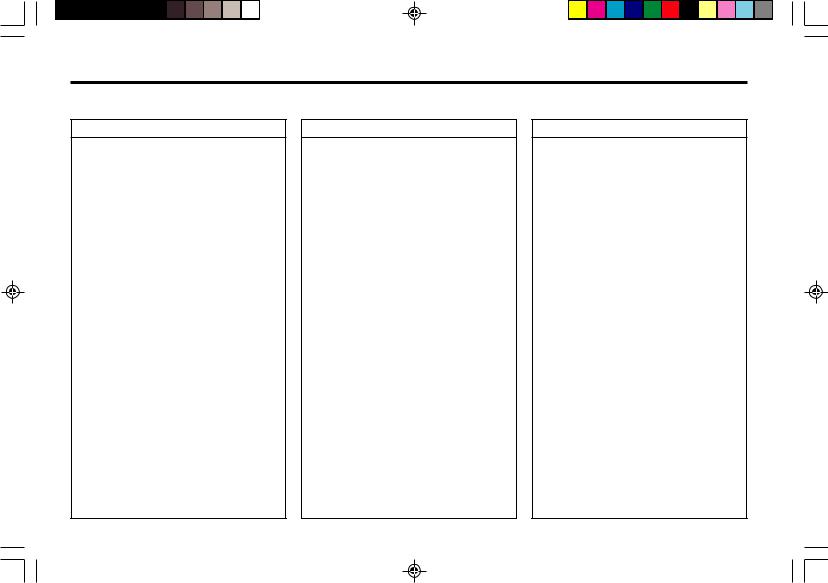
1–4 SEATS AND OCCUPANT PROTECTION SYSTEMS
v WARNING
SAFETY BELTS PROTECT
Accident statistics show that drivers and passengers properly wearing safety belts have a lower risk of being injured and a higher chance of surviving an accident. For this reason, wearing a safety belt is legally required in most countries.
WEARING THE SAFETY BELT
Each front seat and each outboard rear seat of your vehicle is equipped with a three-point safety belt system that is anchored at three locations. Both front seats and outboard rear seats’ belts are stored and locked by a retractor mechanism. When set in its normal emergency locking mode, the three-point safety belt requires no length adjustment and allows freedom of movement when the vehicle moves at constant speeds.
(Continued)
v WARNING
However in a sudden or strong stop, or during heavy acceleration or deceleration, the safety belt will lock automatically to restrain the body.
In order to gain the full benefit of a safety belt, you must wear it correctly and position yourself correctly within your seat, as follows:
•Seatback upright (not reclined, to keep you from “submarining” or slipping out from under the safety belt, and injuring vulnerable body parts in a crash.)
•Occupant sitting upright (not slouched, to properly position the lap and shoulder portions of the safety belt for maximum restraint and minimum injury to soft and vulnerable parts of your body in a crash)
•Safety belt latch plate and buckle securely fastened with a “click” (if the seat belt is not securely latched, it cannot provide any protection; pull on the belt to make sure it is
secure) |
(Continued) |
vWARNING
•Lap portion of safety belt snug and low on hips and bony pelvis (not abdomen where the restraining belt could cause serious injury in a crash – THIS IS PARTICULARLY IMPORTANT FOR PREGNANT WOMEN)
•Shoulder portion of the safety belts over your outside shoulder and snug against the chest (not under an arm, around your neck, over an inside shoulder or behind your back, and not loose with slack allowing excessive forward movement and injury in a crash)
•Knees straight forward (so the driver’s side front knee bolsters can help prevent you from “submarining” under the belt in a crash)
(Continued)
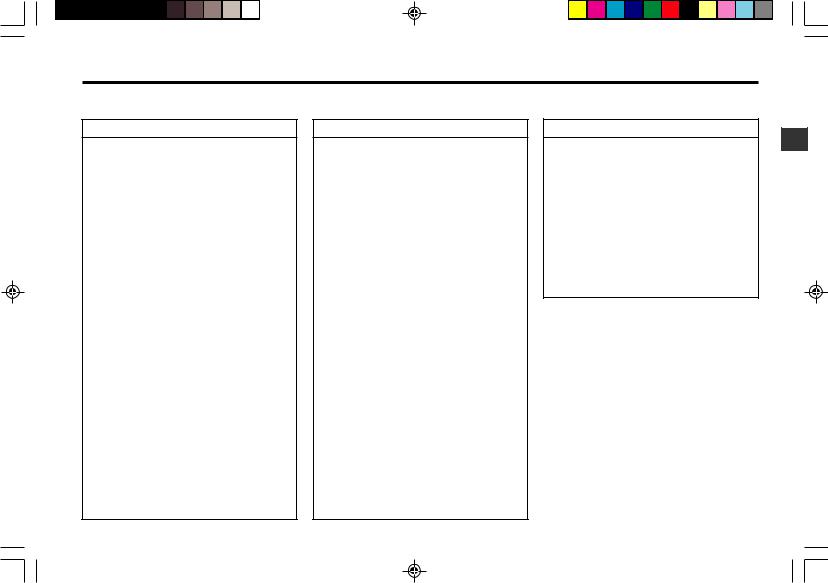
SEATS AND OCCUPANT PROTECTION SYSTEMS 1–5
vWARNING
•Only one occupant per one safety belt (do not allow more than one person in a safety belt; multiple people in a single safety belt can exceed the capacity of the safety belts and people sharing a safety belt can cause crushing and other injuries to each other in a crash)
•Children in secure child seats (in a crash the forces are too great for an adult to hold onto a child and the adult will crush the child if they share the same safety belt)
•No unbelted occupants (occupants not wearing a safety belt are an injury threat to themselves and to other occupants in the vehicle because in a crash they become a free-flying body that will strike other persons in their path)
(Continued)
vWARNING
•No twisted seat belts (twisted seat belts will not move freely and restrain properly and can cut into the occupants rather than spread the force, thus increasing the risk of injury and death)
•Lock doors (unlocked doors increase the risk of injury and death from external impacts and ejection in a crash)
•Make periodic checks (while riding in the vehicle, check from time to time to be sure that the lap portion of the belt is snugly across the hips and has not ridden up around the waist and that the shoulder portion is midway over the shoulder and across the chest; properly positioned belts allow the stronger structures of the hips and shoulders to absorb the forces of the belt against the body, while improperly positioned belts may cause neck injury or injury to the vulnerable organs in the abdominal area).
v WARNING
If the safety belt goes over an armrest (if so eqipped), lap portion of the safety belt could force the occupant’s abdomen, not the bony pelvis, in a collision.
•Be sure that the safety belt goes under the armrests.
Failure to follow this can result in injuries or even death in case of a collision.

1–6 SEATS AND OCCUPANT PROTECTION SYSTEMS
FRONT SEAT OCCUPANTS
Each front seat is equipped with adjustable seat and seatback with height-ad- justable head restraint, three point lap- and-shoulder safety belts, and a supplemental restraint system (air bag).
REAR SEAT OCCUPANTS
The rear seat is equipped with two outboard seating positions and a center seating position featuring three-point lap-and-shoulder safety belts.
Each outboard seating positions are equipped with child restraint lower anchors. (See “LOWER CHILD RESTRAINT ANCHORS” in the index for more information)
SAFETY BELT WARNING CHIME
The safety belt warning chime will sound for about 6 seconds when the ignition switch is ON unless the driver’s safety belt is securely fastened. If you hear this warning chime, make sure the driver’s safety belt is securely fastened before operating the vehicle.
THREE-POINT SAFETY BELTS
To help reduce the risk of personal injury in collisions or sudden maneuvers, your vehicle is equipped with threepoint safety belts. The two front seats, the two outboard rear seating positions and a center rear seating position are each equipped with three-point safety belts. These safety belts are each anchored in three locations to restrain passengers who are properly positioned and wearing the safety belt.
A three-point safety belt set in the ELR (Emergency Locking Retractor) mode requires no length adjustment and allows the freedom of body movement when the vehicle moves at a constant speed.
However, in the event of a sudden or strong stop, or during heavy acceleration or deceleration, the safety belt will lock automatically to restrain the body.

SEATS AND OCCUPANT PROTECTION SYSTEMS 1–7
Always fasten your safety belts correctly:
1.Close and lock the doors.
2.Make sure seatback is upright.
3.Pick up the safety belt latch plate and use it to pull the belt across your body. Make sure the belt is not twisted. If the seat belt locks as you are pulling it out, allow it to rewind into the retractor. Pull the seat belt out again to a comfortable and secure length.
4.Position the shoulder belt midway over the shoulder and across the chest. Never place the shoulder belt
S3W1061A |
across the neck. This assures that in the case of a collision, the belt applies force to the shoulder bones and keeps the impact away from ribs or neck, helping to avoid serious internal injuries.
5.Wear the lap belt low and snug on the hips, not the waist. This assures that in the case of a collision, the belt applies force to the pelvic bones and not the abdomen, helping to avoid serious injuries.
6.Push the latch plate firmly into the buckle until the mechanism clicks. Make sure you are using the proper buckle. Be sure to position the release button on the buckle so you can unbuckle the seat belt quickly if necessary.
7.Pull up on the latch plate to make sure it is secure.
To remove the seat belt, press the red button on the buckle. The belt will retract automatically. Guide the safety belt as it retracts to prevent the latch plate from damaging interior surfaces or injuring occupants.
S3W1062A |
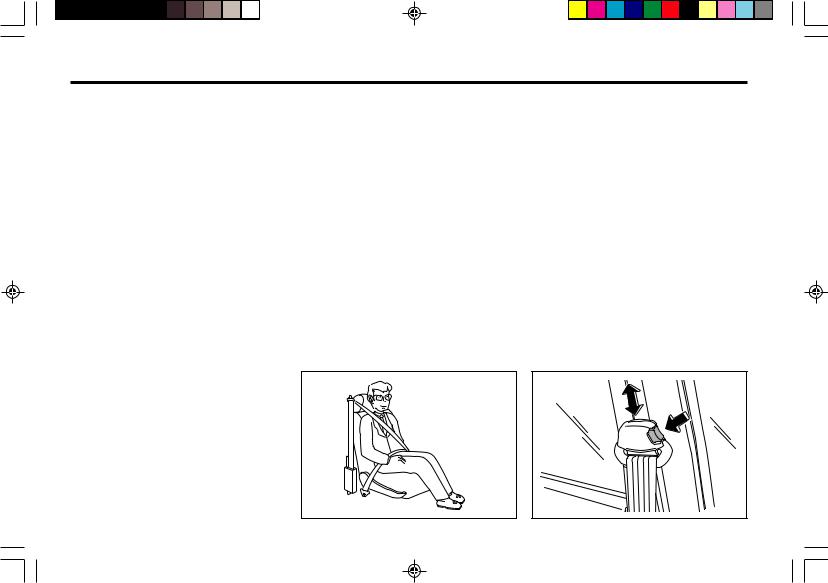
1–8 SEATS AND OCCUPANT PROTECTION SYSTEMS
Maintain your safety belts:
1.Periodically inspect all safety belts, related parts, and assemblies. Have these replaced by a authorized repairer if any safety belts, assemblies or related parts are damaged.
2.You must replace any safety belt or related part that has been stretched or damaged in an accident, even if the stretching or damage is not obvious or visible. Stretched belts and damaged parts do not perform effectively. Replacement safety belts must be new.
3.We recommend replacing the entire safety belt assembly after your vehicle has been in a collision. If your authorized repairer finds that no safety belt damage has occurred and that everything is in proper working order, you need not make any replacement.
4.It is dangerous to operate your vehicle with damaged safety belts or other parts.
SAFETY BELT PRETENSIONER
The safety belt for each of the front seats is equipped with an automatic belt pretensioner.
Restraint systems with a safety belt pretensioner reduce the risk of injury in the event of a head-on collision.
These safety belt pretensioners are always activated in a severe head-on collisions so that the driver and front passenger are held securely in their seats.
The safety belt pretensioner is not triggered in minor frontal, rear or side collisions or rollovers.
If the pretensioner has been activated because of an accident or any other reason, the pretensioner and seat belt must be replaced.
L3W1081A
SAFETY BELT HEIGHT ADJUSTMENT
To operate safety belts with a heightadjustable upper anchorage point, do the following:
1.Pull on the safety belt.
2.Press the safety belt height adjustor in the area indicated by the arrow in the illustration.
3.Adjust the safety belt height before you begin driving, so that the shoulder belt lies midway across the shoulder closest to your door.
S3W1071A |

SEATS AND OCCUPANT PROTECTION SYSTEMS 1–9
v WARNING
Misadjustment of the safety belt height could reduce the effectiveness of the safety belt in a crash.
v WARNING
Never drive with an improperly positioned safety belt. To help avoid injuries, always observe the following precautions:
•Adjust the safety belt height before driving.
•Wear the shoulder belt midway across the shoulder.
•Lock the seat belt anchor in position.
Failure to follow these precautions can result in injuries or even death in case of a collision.
REMOVABLE CENTER REAR SAFETY BELT
Your vehicle is equipped with a removable center rear safety belt. This safety belt system includes a retractable safety belt, a buckle with black release button, a buckle with red release button marked “CENTER”, which forms the three point safety belt.
See “THREE POINT SAFETY BELT” in the index to learn how to use the three point safety belt system properly.
v CAUTION
Use the strap guide for designed purpose only(Hatchback models only).
•Do not use the strap guide as a handle when folding or restoring the rear seatback.
•Do not hold harnesses, rear outboard safety belts or other items or equipment in your vehicle.
To install the center rear safety belt:
1.Pull the center rear safety belt from the retractor.
2.Push the latch plate at the end of the safety belt strap into the buckle with black release button until the mechanism clicks. Make sure the strap is not twisted. You must be able to see the metal part of the latch plate as shown in the illustration when you finish this step.
NOTE
The latch plate at the end of the center safety belt strap only fits in the buckle with black release button.
Hatchback only |
2 |
Metal part |
facing forward |
1 |
S3W1081A |
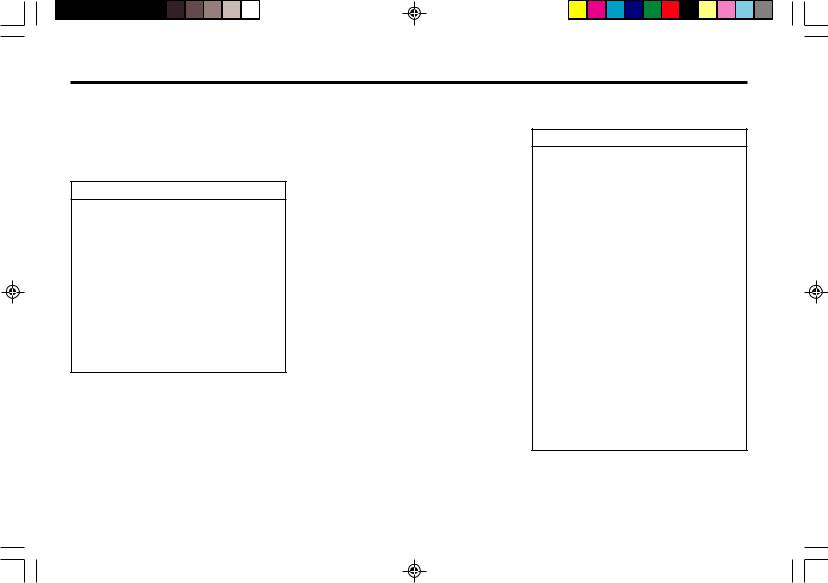
1–10 SEATS AND OCCUPANT PROTECTION SYSTEMS
3.(Hatchback models only) Insert the upper part of the strap into the strap guide making sure the strap is not twisted.
vWARNING
•After a collision, inspect all safety belts and related parts for fraying or other damage. Ask your Authorized Service Operation to replace any damaged parts.
•It is dangerous to operate your vehicle with damaged safety belts or other parts.
Failure to make appropriate repairs may result in additional damage to your vehicle or personal injuries.
PREGNANT WOMEN AND SAFETY BELTS
Safety belts work for everyone, including pregnant women.
Like all occupants, pregnant women are more likely to be seriously injured if they do not wear safety belts. In addition, when a safety belt is worn properly, it is more likely that the unborn child will be safe in a crash.
To provide maximum protection, a pregnant women should wear a threepoint safety belt. She should wear the lap portion of the belt as low as possible throughout her pregnancy.
CHILD RESTRAINT
v WARNING
Child safety restraints are available in a wide range of sizes and configurations. Due to the shape and dimensions of your vehicle’s interior and seats, not all child safety restraints will fit in your vehicle.
It is your responsibility to ensure that the child safety restraint you are installing fits properly and can be adequately attached to the vehicle with the safety belts and the child safety restraint anchors.
A child safety restraint that is not the correct size for the vehicle or the child, or a child safety restraint that is improperly attached to your vehicle can lead to serious personal injury to the child and other passengers in the vehicle in the event of a collision.
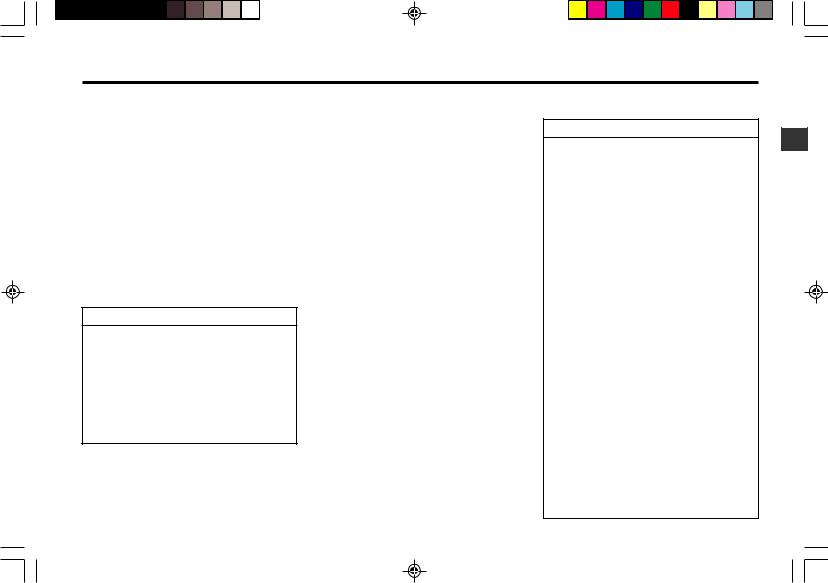
SEATS AND OCCUPANT PROTECTION SYSTEMS 1–11
Once you have selected an appropriate infant or child restraint, read and carefully follow the manufacturer’s instructions for installing and using the system. The child restraint system should be appropriate for your child’s age, height and weight; and it should fit properly and securely in the vehicle. There are different kinds of restraint systems that are available for all sizes of children until they reach a height and weight at which they can safely use the vehicle’s safety belt system.
v WARNING
Your vehicle is designed to fit universal child restraint seat only to the each rear outboard seating positions.
•Do not install universal child restraint seat to the front passenger’s seat and/or rear center seating position.
Accident statistics show that children are safer in accidents when they are restrained in the rear seat rather than the front seat of the vehicle.
Children who have outgrown their child restraint system should sit in the rear seat, restrained by the safety belt that is fastened properly, making sure that the shoulder portion is adjusted to be as far away from the neck as possible and that the lap portion is low across the hips. Check the belt position from time to time to verify that it is safely positioned.
If the child must sit in a front seat, make certain that the shoulder belt does not lie across the child’s face or neck. If it does, move the child closer to the center of the vehicle so that the safety belt is on the child’s shoulder.
Never let the child stand or kneel on the seat, or in the cargo areas, while your vehicle is moving.
When the child seat is not in use, secure the seat with the vehicle’s safety belt or remove it from the vehicle.
vWARNING
•Never hold a baby in your arms while riding in a vehicle. Be sure to secure infants and small children in restraints approved for their use.
•During a crash, a baby will become so heavy you can’t hold it. For example, in a crash at only 25 mph (40 km/h), a 12-lb (5.5 kg) baby will become a 240-lb (110 kg) force against your arms.
•Failing to secure infants and small children in restraints approved for their use can result in injury during a collision, or even death.
•According to accident statistics, children are safer when properly restrained in the rear seats than in a front seat.
•Do not install any child restraint in the front passenger’s seat if your vehicle is equipped with side air bag.
See “SIDE AIR BAGS” in the index for more information.
(Continued)

1–12 SEATS AND OCCUPANT PROTECTION SYSTEMS
v WARNING
(Continued)
•Extreme Hazard! Do not use a rearward facing child restraint on a seat protected by an air bag in front of it! Always secure a rearfacing child restraint in the rear seat.
S3W1101A
LOWER CHILD RESTRAINT ANCHORS
In the past, child restraints have been attached to a vehicle’s seat by safety belts. As a result, child restraints were often installed incorrectly or too loosely to adequately protect your child. We now equip your vehicle with Lower Child Restraint Anchors at the two rear outboard seating positions, allowing child restraints to be attached directly to the body of the vehicle.
Lower anchors
S4W1111A
To install a child restraint which comes equipped with lower anchor attachments, follow the instructions supplied with your child restraint and the “Installation of Child Restraints with Lower Anchor Attachments” procedure on the following pages of this manual.
Please take the time to carefully read and follow all of the instructions on the following pages and the instructions supplied with your child restraint.
Your child’s safety depends on it!
If you have questions, or any doubts whether you have installed your child restraint properly, contact the child restraint manufacturer. If you are still having trouble installing the child restraint in your vehicle, please consult your authorized repairer.
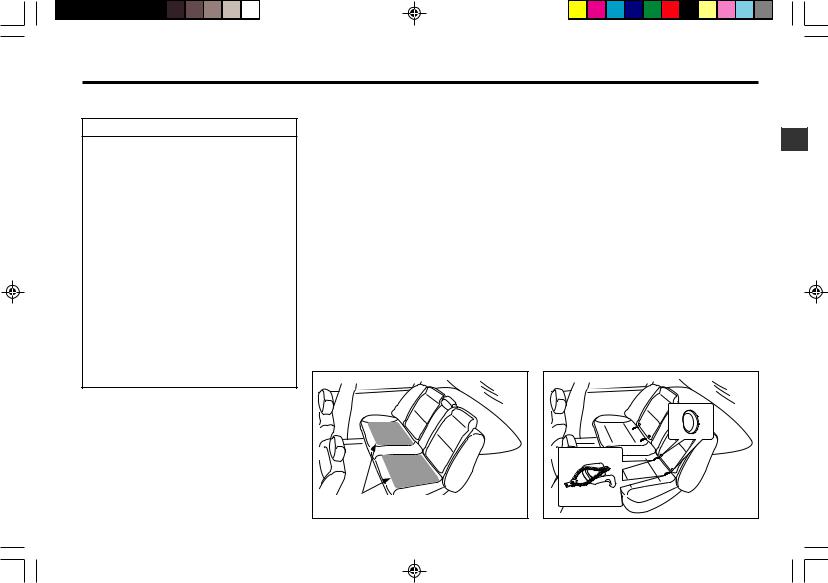
SEATS AND OCCUPANT PROTECTION SYSTEMS 1–13
v WARNING
Use all child restraint anchors for their designed purpose only.
Child restraint lower anchors are designed only to hold child restraints which come equipped with lower anchor attachments.
•Do not use child restraint lower anchors to hold adult safety belts, harnesses, or other items of equipment in your vehicle.
Using child restraint anchors to hold adult safety belts, harnesses, or other items or equipment in your vehicle will not provide adequate protection in the case of a collision and could result in injuries or even death.
Installation of child restraints with lower anchor attachments
To install a child restraint designed for attachment to lower anchors:
1.Select one of the rear outboard seating positions for installation of the child restraint.
2.Locate the two Lower Child Restraint Anchor positions. The location of each lower anchor is identified with a circular marking on the lower edge of the rear seatback.
3.To access the Lower Child Restraint Anchors, fully open the zippers covering each of the two anchors.
Proper installation positions
S4W1121A |
S3W1122A |
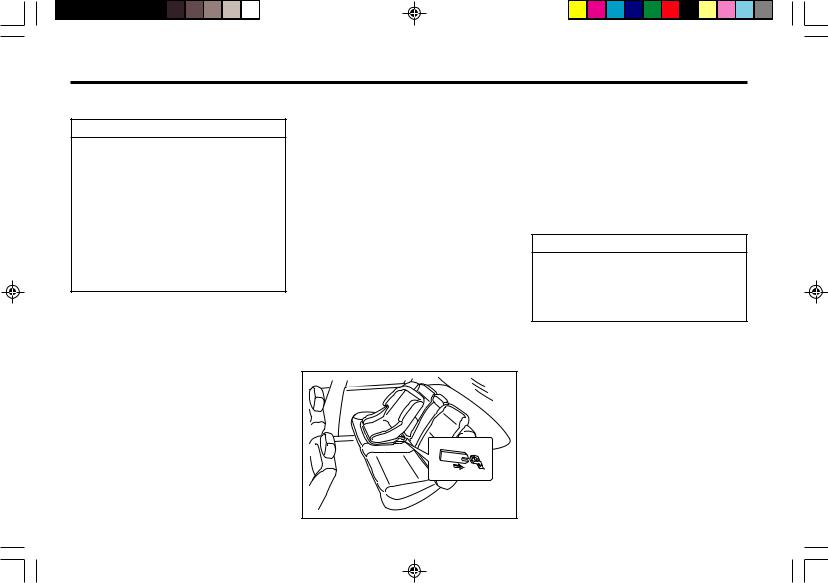
1–14 SEATS AND OCCUPANT PROTECTION SYSTEMS
vCAUTION
•Keep the zippers covering the Lower Child Restraint Anchors closed when the anchors are not in use.
Leaving the zipper covers open could allow foreign objects to accumulate around the Lower Child Restraint Anchors, interfering with the proper latching of the child restraint to the anchors.
4.Make sure there are no foreign objects around the Lower Child Restraint Anchors, including safety belt buckles or safety belts. Foreign objects can interfere with the proper latching of the child restraint to the anchors.
5.Place the child restraint on the seat over the two Lower Child Restraint Anchors and attach it to the anchors following the instructions supplied with the child restraint.
6.Adjust and tighten the child restraint according to the instructions supplied with the child restraint.
7.Push and pull on the child restraint after installation to be sure the child restraint is secure.
HEAD RESTRAINTS
Head restraints are designed to reduce the risk of neck injuries in case of a collision.
For maximum protection, slide the head restraint up or down so the top of the restraint is level with the top of your ears.
v WARNING
S4W1123A |
Removed or improperly adjusted head restraints can result in serious head and neck injuries in case of a collision.
To adjust the front and rear* head restraints, raise the head restraint or push it down while pressing the release button.
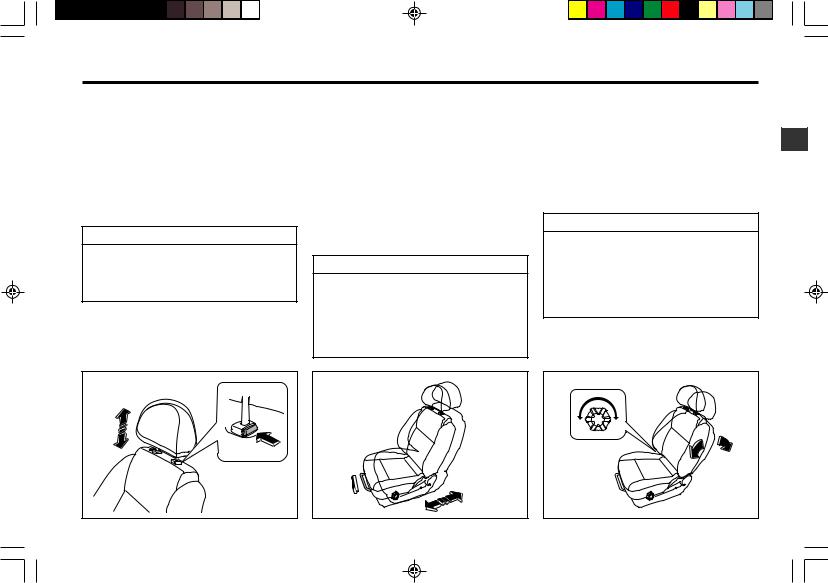
SEATS AND OCCUPANT PROTECTION SYSTEMS 1–15
If the head restraint must be removed for any reason,
1.Pull it up to the stop position.
2.While pushing the release button, lift the head restraint from the guide sleeve.
v WARNING
Make sure that the head restraint has been put back into place and readjusted before driving.
3.Replace head restraint and reset it in intended position before driving.
FRONT SEATS
FRONT SEAT SLIDE ADJUSTMENT
To move the front seat forward or backward:
1.Pull up and hold the lever located under the front side of the front seat.
2.Slide the seat to the desired position.
3.Release the lever.
vWARNING
•Do not adjust the driver’s seat while the vehicle is moving.
Driver could lose control of the vehicle and injury or property damage could result.
FRONT SEAT RECLINING ADJUSTMENT
To tilt seatback forward or backward, turn the handwheel on the inside of the seatback until the seatback is adjusted to the desired position.
vWARNING
•Do not adjust the driver’s seatback while the vehicle is moving.
Driver could lose control of the vehicle and injury or property damage could result.
S3W1131A |
S3W1141A |
S3W1151A |
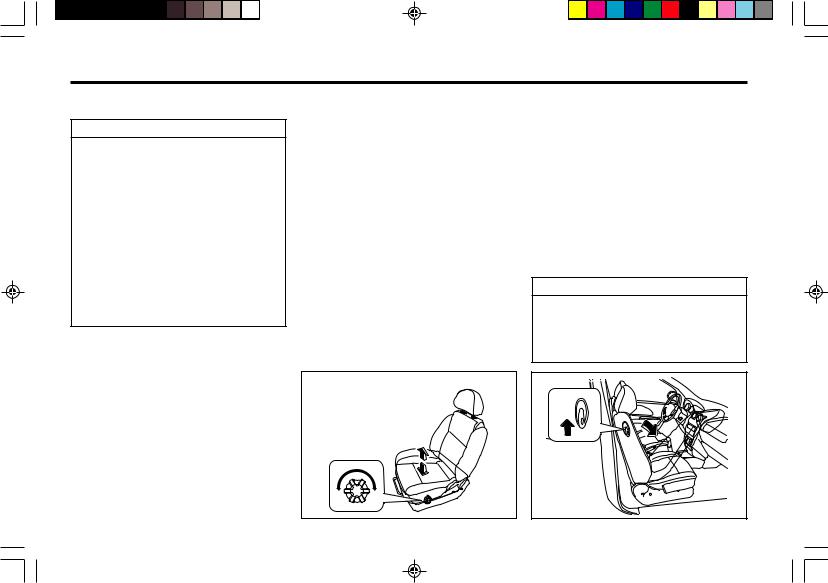
1–16 SEATS AND OCCUPANT PROTECTION SYSTEMS
v WARNING
If a crash occurs, front occupants in reclined seats can lose restraining benefits of the seatback and safety belts by sliding out from under the safety belt or by being thrown into the seat belt in an awkward position.
•Do not position either front seatback in the reclined position while the vehicle is being operated.
Serious injuries, death and ejection from the vehicle can result.
DRIVER’S SEAT HEIGHT ADJUSTMENT*
To adjust the position of the driver’s seat cushion, turn the handwheel on the outside of the seat cushion until the seat cushion is adjusted to the desired position.
EASY ENTRY FRONT SEATS*
(3 door hatchback only)
To facilitate entering and leaving the rear seat area, tilt the front seatback forward by pulling up the release lever on the outboard side of the seat back.
To return the seat back to the original position, lift up the seat back and push it firmly into position.
v WARNING
When returning the seat back, make sure it is securely latched in place by pushing rearward on top of seat back.
S3W1161A |
S5W1002A |

SEATS AND OCCUPANT PROTECTION SYSTEMS 1–17
REAR SEATS
FOLDING REAR SEATBACK
vWARNING
•Do not stack luggage or other cargo higher than the front seats.
•Do not allow passengers to sit on the folded seatbacks while the vehicle is in motion.
•Your vehicle has separate areas designed specifically for carrying cargo or passengers.
•Unrestrained luggage or passengers on a folded seatback can be thrown about within or ejected from the vehicle in a sudden stop or accident.
Serious injuries or death can result.
To fold down the rear seatbacks separately:
1.Pull up on the release knob on top of the rear seatback.
2.Fold the rear seatback forward and down.
To return a rear seatback to its original position:
1.Hook the safety belts to the retaining guide to make sure the safety belts are not pinched by the latch.
2.Lift the rear seatback and push to original position.
3.Latch the seatback into place by pushing on the top of the seatback.
4.Pull the seatback forward again to make sure the seatback is properly latched.
5.Unhook the safety belts from the retaining guide.
 Retaining guide
Retaining guide
S4W1171A |
S5W1001A |
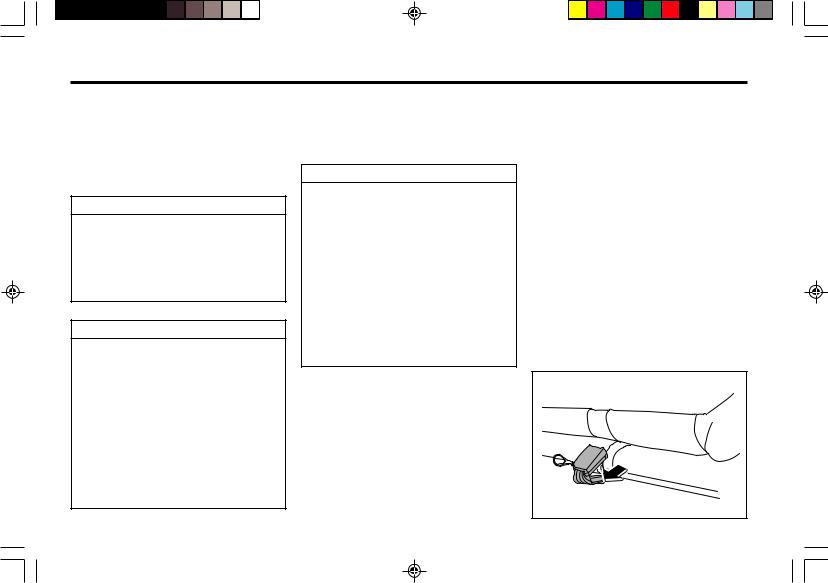
1–18 SEATS AND OCCUPANT PROTECTION SYSTEMS
6.Install the center rear safety belt.
See “REMOVABLE CENTER REAR SAFETY BELT” in the index for installation.
vCAUTION
•Make sure the safety belts are hooked to retaining guide.
Failure to follow this precaution can result in the damage of your safety belts.
vWARNING
•Ensure that the rear seatbacks are all the way back and locked in position before operating the vehicle with passengers in the back seat.
•Do not pull the release knobs on the top of the seatback while the vehicle is moving.
Pulling the release knobs while the vehicle is moving can cause injuries or damage to the occupants.
DOUBLE FOLDING REAR SEAT (HATCH BACK ONLY)
vWARNING
•Do not stack luggage or other cargo higher than the front seats.
•Do not allow passengers to sit on rear compartment when the rear seats are folded forward.
•Unrestrained luggage or passengers in rear compartment can be thrown about within or ejected from the vehicle in a sudden stop or accident.
Serious injuries or death can result.
To fold the rear seat forward to increase luggage space:
1.Fold down the rear seatback.
See “FOLDING REAR SEATBACK” earlier in this section.
2.If your vehicle is equipped with adjustable headrest, push the head restraints fully down.
See “HEAD RESTRAINTS” in the index.
3.Pull the safety belt and safety belt buckles out of the space between seatback and seatback cushion.
S3W1181A |
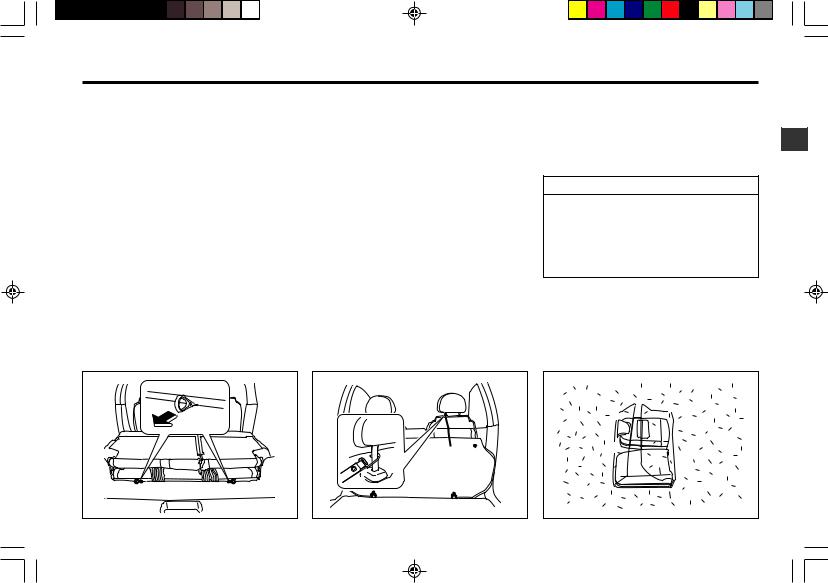
SEATS AND OCCUPANT PROTECTION SYSTEMS 1–19
4.Unlock the rear seat cushion by pulling the release handles on the rear side of the seat cushion backward.
5.Lift and fold the seat up and hold it to the headrest of the front seat using built-in hook.
6.Place the rear safety belt and safety belt buckles into the storage beneath the floor mat.
v CAUTION
When the rear seat is folded forward, place the rear safety belt and safety belt buckles in the storage to prevent damage of the safety belt and buckle by careless handling.
S3W1182A |
S3W1183A |
S3W1184A |

1–20 SEATS AND OCCUPANT PROTECTION SYSTEMS
To return the rear seat to its original position:
1.Release the hook from the headrest of the front seat.
2.Guide the rear seat cushion down making sure that the rear safety belt and the safety belt buckles are out of their storage.
v CAUTION
Damage to the safety belt buckle or rear seat locking mechanism can occur if the safety belt and buckles are pinched under the rear seat cushion.
•Do not place the safety belt and buckles on the floor under the rear seat cushion when the rear seat is set back to the sitting position.
3.Lock the rear seat cushion on the floor. Make sure that the rear seat cushion is securely latched by pulling it up and down.
4.Return the rear seatback to its original position. Make sure that the seatback is securely latched by pulling it back and forth. See “FOLDING REAR SEATBACK” in the index or earlier in the section.
5.Put the rear safety belt and the buckles back into the space between the rear seatback and the seat cushion.
Make sure that the straps of the safety belt are not twisted.
vCAUTION
•Make sure the safety belts are hooked to retaining guide.
Failure to follow this precaution can result in the damage of your safety belts.
S3W1185A |
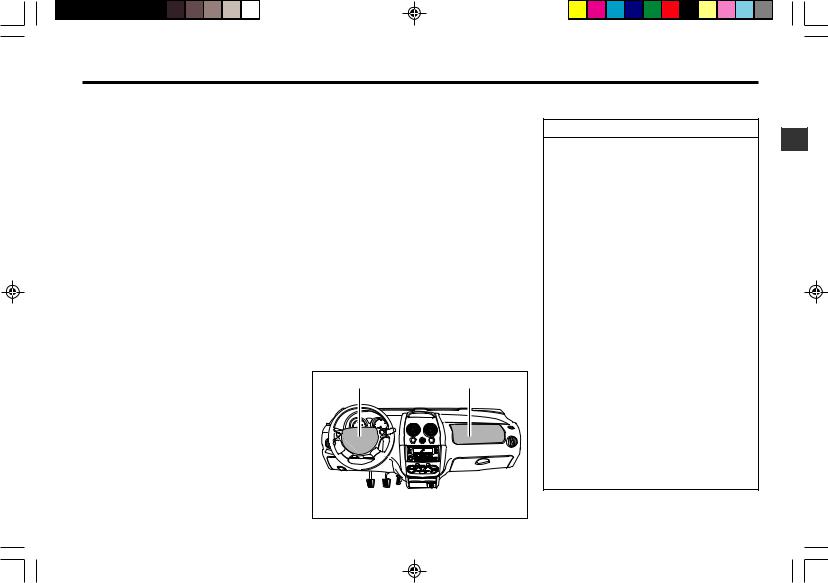
SEATS AND OCCUPANT PROTECTION SYSTEMS 1–21
SUPPLEMENTAL RESTRAINT SYSTEM (AIR BAG)
Your vehicle is equipped with an air bag supplemental restraint system (SRS) designed to protect properly seated and restrained front seat occupants. Both the driver and front passenger seating positions are equipped with driver and passenger air bags and side air bags (if so equipped), in addition to three-point safety belts and other safety features. Each air bag is specially packed in a module, from which the air bag is designed to inflate and deploy at extremely high speed and force in the event your vehicle is involved in certain types of collisions which pose a high risk of serious injury or death to the driver and passengers.
DRIVER’S AND FRONT PASSENGER’S AIR BAG
Driver’s air bag
The driver’s air bag module is located in the center of the steering wheel.
Front passenger’s air bag*
The passenger’s air bag module is located in the instrument panel, above the glove box.
Driver’s air bag |
Front passenger’s |
|
air bag |
|
S3W1201A |
 WARNING
WARNING
Air bags are only a supplemental restraint, and are most effective in combination with safety belts.
All occupants, including the driver, should always wear their safety belts, whether or not an air bag is also provided at their seating position, to minimize the risk of severe injury or death in the event of a crash.
•Air bags do not deploy in side or rear collisions. Occupants not wearing their safety belts will not be protected by any restraint system, resulting in severe injuries or death in these types of collisions.
•Occupants who are not properly wearing their safety belts may be thrown forward by braking before impact, placing their bodies near or against the air bag modules. This can cause severe injury from the force of an air bag’s deployment.
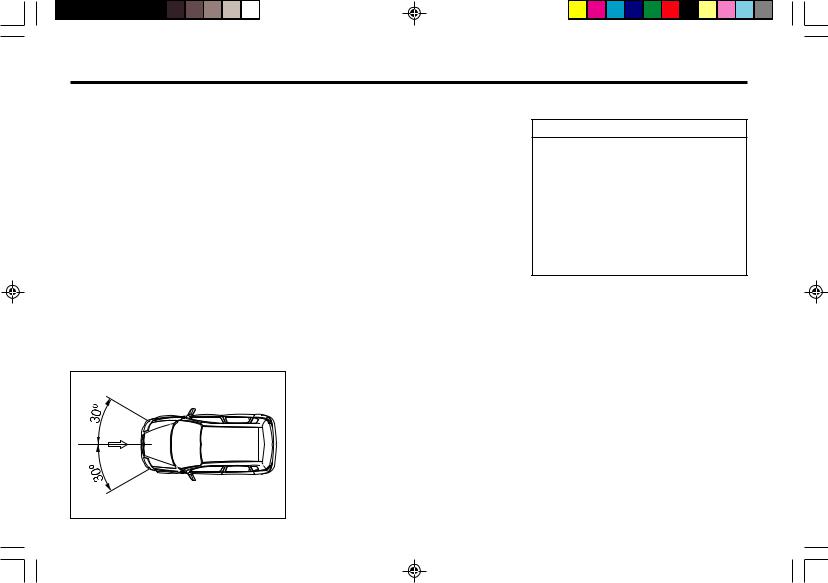
1–22 SEATS AND OCCUPANT PROTECTION SYSTEMS
How air bags work
Air bags are designed to keep your head, neck, and chest from slamming into the instrument panel, steering wheel or windshield in a front-end crash. They are not designed to inflate in rear-end or rollover crashes or in most side-im- pact crashes. Your air bags are designed to deploy in crashes that are equivalent to, or exceed the force of a vehicle traveling at a speed of 9 to 14 mph (14.5 ~ 23 km/h) crashing into a solid immovable wall.
This crash severity level at which the air bag will deploy was selected to assure inflation of air bags in vehicles at
S3W1202A
or below the crash severity at which a statistical risk of death begins for frontal collisions.
In the real world, cars rarely crash squarely into immovable walls; air bags most often deploy when a vehicle collides with another vehicle. The actual speed at which the air bags will inflate may be higher in the real world, because real-world accidents usually involve more complicated multi-vehicle impacts, angled impacts, and incomplete frontal impacts (e.g. sideswipes), and because the object struck is usually not immovable. Because another vehicle soaks up some of the force of impact, unlike an immovable wall, an 9 to 14 mph (14.5 ~ 23 km/h) crash into an immovable wall is equivalent to a headon full frontal impact with a stationary vehicle of equal size and weight, while traveling at a speed of 16 to 28 mph (26 ~ 45 km/h).
NOTE
An air bag can also inflate in moderate to severe non-collision situations (e.g., slamming the undercarriage or other solid component of the vehicle in a dip in the driving surface) where the crash sensors generate a signal equivalent to a crash into a solid immovable barrier at 9 to 14 mph (14.5 ~ 23 km/h)
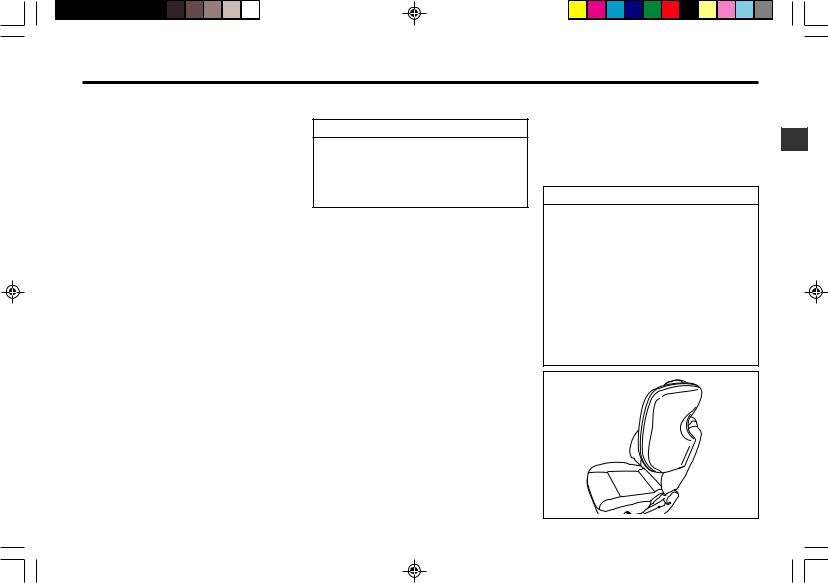
SEATS AND OCCUPANT PROTECTION SYSTEMS 1–23
Air bags inflate when a sensor detects a front-end crash of a severity sufficient for air bag deployment. The crash sensor sends an electric signal to initiate the air bag’s inflation. A propellant is ignited which rapidly burns inside the air bag module, producing enough nitrogen gas to fully inflate the air bag. The chemical process and nitrogen gas are harmless to the vehicle’s occupants. Within 0.045 seconds of the crash detection, the pressure of the inflating air bag splits open the plastic trim covering on the module, which is scored on the inside surface to allow the trim of the steering wheel hub or passenger-side instrument panel to split open under force.
The air bag fully inflates to create a surface that can catch the forward movement of the front occupant’s head and upper torso. As the occupant comes into contact with the air bag, the gas in the bag empties through holes at the base of the bag to soak up the force from the occupant’s forward movement.
NOTE
Air bags cannot smother you and they don’t restrict your movement. Air bags have vents, so they deflate immediately after cushioning you.
The entire process, from initial contact through the air bag’s inflation and deflation, occurs within 0.2 seconds, faster than the blink of an eye. Because the collision is over in a fraction of a second, and vehicles involved in an accident usually come to the final point of rest only one or two seconds after initial contact, the supplemental restraint system must sense the crash and cause the air bags to deploy nearly instantaneously to protect the vehicle’s occupants.
SIDE AIR BAGS*
The side air bag modules are located in the outboard side of the front seatbacks.
v WARNING
Air bags are only a supplemental restraint, and are most effective in combination with safety belts.
All occupants, including the driver, should always wear their safety belts whether or not an air bag is also provided at their seating position, to minimize the risk of severe injury or death in the event of a crash.
(Continued)
S3W1211A
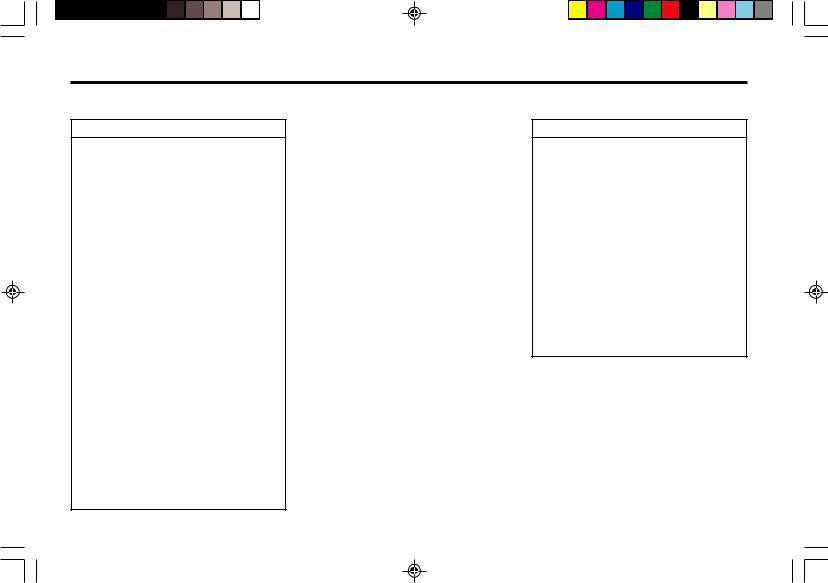
1–24 SEATS AND OCCUPANT PROTECTION SYSTEMS
v WARNING
(Continued)
•Do not place objects on or near the side air bag modules in the outboard side of each front seats. They can become projectiles during inflation, causing severe injury.
•Do not install accessory seat covers on the front seats. The deployment of the side air bags can be obstructed in a collision leading to serious injury.
•Do not lean your body part or head on the door. The side air bag can hit the occupants with a considerable force when it deploys in a collision leading to serious injury.
•Do not install any child restraint in the front passenger’s seat if your vehicle is equipped with the side air bag.
Failure to follow these precautions can result in serious injury or even death.
How the side air bags work
Side air bags are designed to keep your head, neck, arm, and shoulder from slamming into the front door and window in a lateral crash.
The side air bags inflate when a sensor detects a lateral crash of a severity sufficient for the side air bag deployment.
Your side air bags are designed to deploy in lateral collisions that are equivalent to, or exceed the force of a vehicle traveling at a speed of 15.5 mph (25 km/h) crashing into a solid immovable wall.
The fact that your vehicle was involved in a crash and the side air bags did not inflate does not necessarily mean that there is something wrong with your side air bags. Side air bags are designed to inflate in a side collision, not in frontend, rear-end, or rollover crashes if they don’t produce sufficient lateral impact for the deployment of the side air bags.
v WARNING
Children who are seated in close proximity to a side air bag may be at risk of serious or fatal injury if the air bag deploys, especially if the child’s head, neck, or chest is close to the air bag at the time of deployment.
•Never let your child lean on the door or close to the side air bag module.
•Make sure that the safest place in the vehicle for your properly seated and restrained child is the back seat.
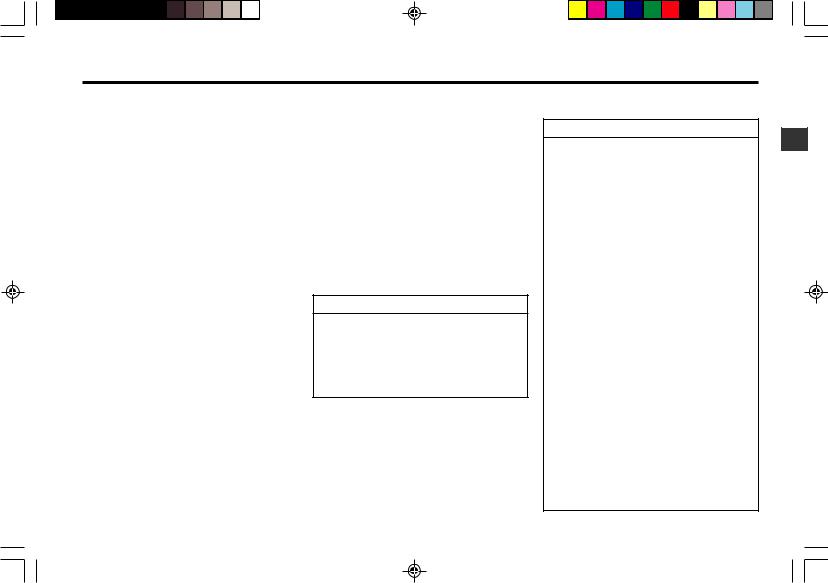
SEATS AND OCCUPANT PROTECTION SYSTEMS 1–25
AFTER THE AIR BAG DEPLOYS
After the air bag deflates, you may notice a burning smell, smoke, and white powder in the interior of the vehicle. This is normal. The burning smell is from the propellant that was ignited to inflate the airbag. The white powder is cornstarch or talcum or sodium compounds which lubricate the air bag to reduce friction on the air bag during storage and inflation. Although they may cause some skin or eye irritation, these substances are not toxic.
SRS SERVICING
Your Supplemental Restraint System (SRS) is virtually maintenance free.
However, if any of the following occurs, have your SRS serviced immediately by an authorized repairer.
•Any of your air bag has deployed.
•The air bag warning lamp indicates malfunction. See “AIR BAG WARNING LAMP” in the index.
NOTE
If your vehicle is equipped with side air bags, the front seat assembly must be replaced after the side air bag has been deployed. Contact your authorized repairer for more information.
vWARNING
•Do not drive your vehicle after one or more air bags have deployed.
•Do not try to repair, alter, or dispose of the air bag yourself.
•Air bags are installed under high pressure with sophisticated crash sensing and air bag inflating systems. Allowing an untrained and unauthorized person to handle an air bag can lead to serious injuries and death.
•Contact your authorized repairer immediately if either of your vehicle’s air bag has deployed, if damage occurs to your vehicle at or near either of the air bag modules, or if you believe for any reason that the operating condition of either air bag has been impaired.
Driving a vehicle after an air bag has deployed without authorized service can result in severe injuries and death.

1–26 SEATS AND OCCUPANT PROTECTION SYSTEMS
HOW AIR BAGS PROTECT FRONT OCCUPANTS
Vehicle occupants are usually injured in a collision because their bodies are thrown into a stationary object, either inside the vehicle, such as the steering wheel, instrument panel or windshield, or outside the vehicle, such as the driving surface or a tree, when the occupant is thrown from the vehicle. Severe injuries also occur by occupants being jolted by the forces of the crash, even without body contact with a stationary object or surface.
S3W1241A
All of these injuries are caused by the force created by the collision as the vehicle is brought to a sudden stop. The time and distance which a vehicle is allowed in slowing or stopping in great part determines the severity of a collision’s effect on vehicle occupants. For example, when a vehicle brakes to a stop at a red light, the occupant’s bodies are forced forward. This is because both the vehicle and its occupants are initially traveling at the same speed. The brakes slow the vehicle, and the occupants continue to move forward somewhat inside the vehicle. However, properly positioned and restrained occupants are rarely injured when a vehicle comes to a stop by even sudden and hard braking. This is because even hard braking allows a comparatively long time and distance for the vehicle to stop. The safety belts and the occupants’ strength are generally sufficient to safely counteract the force of a braking stop.
In a crash, a vehicle may go from highway speed to a full stop in a fraction of a second and in a distance of less than one foot. This extremely short stopping time and distance greatly increases the force placed upon the occupants. No person has the strength or reflexes to counteract this force. Even occupants properly positioned and wearing their safety belts will find their head, upper torso, arms, and hips thrown forward at the speed the vehicle was traveling before impact. In moderate to severe frontal collisions, even occupants wearing safety belts can sustain internal brain and organ injuries without the occupant’s head or torso hitting any stationary objects or surfaces.
Air bags provide additional stopping time and distance for the head and upper torsos of front occupants in moderate to severe frontal or near-frontal collisions. This additional time and distance can save lives and prevent serious injuries.
